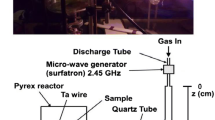Abstract
The reaction scheme of ammonia synthesis in the ECR plasma apparatus teas investigated from both identifications of the species in the plasmas and the adsorbed species on the surface of a steel substrate placed in the plasmas. The adsorbed species were considerably different when different kinds of plasmas are used. NH, species were adsorbed on the steel substrate surface in the nitrogen-hydrogen plasma, and N2 molecules were adsorbed in the nitrogen plasma. By the application of a negative bias potential on the substrate, the adsorption of N atom or Fe-N bond formation was identified on the steel substrate surface. When the stainless steel wall of the chamber was covered with aluminum foil, the yield of NH,, radicals, which were on both the substrate and in the plasma, decreased. By exposure of the substrate, on which N2 molecules or N atoms adsorbed, to the hydrogen plasma, N2 and N disappeared from the steel substrate surface, forming ammonia. Moreover, the adsorption of NH,, radicals disappeared when the stainless steel wall surface was covered with aluminum foil. Thus, the surface of the stainless steel wall acts as a catalyst in ammonia formation. The formation of ammonia in the nitrogen-hydrogen ECR plasma, in which the steel substrate served as the catalyst, is not only through the dissociative adsorption of excited nitrogen molecules but also through the dissociative adsorption of nitrogen molecular ions.
Similar content being viewed by others
References
G. Y. Botchway and M. Venugopalan,Z. Phys. Chem. Neue Folge,120, 103 (1980).
K. S. Yin and M. Venugopalan,Plasma Chem. Plasma Process. 3, 343 (1983).
H. Uyama, T. Nakamura, S. Tanaka, and O. Matsumoto,Plasma Chem. Plasma Process. 13, 117 (1993).
S. Tanaka, H. Uyama, and O. Matsumoto,Plasma Chem. Plasma Process. 14, 491 (1994).
O. Nomura, H. Oyama, and Y. Sakamoto,Sci. Papers I.P.C.R. 75, 124 (1981).
O. Nomura, H. Oyama, and Y. Sakamoto, Proceedings of 6th International Symposium on Plasma Chemistry (1983), p. 681.
H. Uyama and O. Matsumoto,Plasma Chem. Plasma Process.9, 13 (1989).
H. Uyama and O. Matsumoto,Plasma Chem. Plasma Process.9, 421 (1989).
G. Ertl,Successful Design of Catalysts, Elsevier Science Publishers, Amsterdam (1988), p. 351.
M. Grunze, M. Golze, W. Hirschwald, H.-J. Freund, H. Pulm, U. Seip, M. C. Tsai, G. Ertl, and J. Kuppers,Phys. Reu. Lett. 53, 850 (1984).
G. Ertl and M. Thiele,Appl. Surl: Sci. 3, 99 (1979).
E. N. Eremin,Russ. J. Phys. Chem. 49, 1113 (1975).
M. Venugopalan and S. Veprek,Top Curr. Chem. 107, 1 (1983).
O. Matsumoto and K. Takemura, Proceedings of 1 1 th International Symposium on Plasma Chemistry (1993), p. 1063.
T. Fujita and O. Matsumoto,J. Electrochern. Soc. 136, 1645 (1989).
K. Shirai, K. Iizuka, and S. Gonda,Jpn. J. Appl. Phys. 28, 877 (1989).
T. Fujita, C. Inagaki, H. Uyama, and O. Matsumoto,J. Electrochem. Soc. 137, 1645 (1990).
Author information
Authors and Affiliations
Rights and permissions
About this article
Cite this article
Kiyooka, H., Matsumoto, O. Reaction scheme of ammonia synthesis in the ECR plasmas. Plasma Chem Plasma Process 16, 547–562 (1996). https://doi.org/10.1007/BF01447008
Received:
Revised:
Issue Date:
DOI: https://doi.org/10.1007/BF01447008




